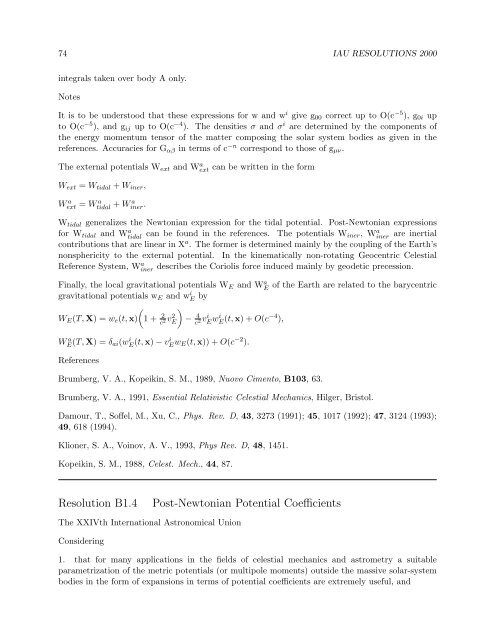USNO Circular 179 - U.S. Naval Observatory
USNO Circular 179 - U.S. Naval Observatory
USNO Circular 179 - U.S. Naval Observatory
Create successful ePaper yourself
Turn your PDF publications into a flip-book with our unique Google optimized e-Paper software.
74 IAU RESOLUTIONS 2000<br />
integrals taken over body A only.<br />
Notes<br />
It is to be understood that these expressions for w and w i give g00 correct up to O(c −5 ), g0i up<br />
to O(c −5 ), and gij up to O(c −4 ). The densities σ and σ i are determined by the components of<br />
the energy momentum tensor of the matter composing the solar system bodies as given in the<br />
references. Accuracies for Gαβ in terms of c −n correspond to those of gµν.<br />
The external potentials Wext and W a ext can be written in the form<br />
Wext = Wtidal + Winer,<br />
W a ext = W a tidal<br />
+ W a<br />
iner .<br />
Wtidal generalizes the Newtonian expression for the tidal potential. Post-Newtonian expressions<br />
for Wtidal and Wa tidal can be found in the references. The potentials Winer, Wa iner are inertial<br />
contributions that are linear in Xa . The former is determined mainly by the coupling of the Earth’s<br />
nonsphericity to the external potential. In the kinematically non-rotating Geocentric Celestial<br />
Reference System, Wa iner describes the Coriolis force induced mainly by geodetic precession.<br />
Finally, the local gravitational potentials WE and Wa E<br />
gravitational potentials wE and wi E by<br />
<br />
WE(T, X) = we(t, x)<br />
1 + 2<br />
c2 v2 <br />
E − 4<br />
c2 vi Ewi E (t, x) + O(c−4 ),<br />
W a E (T, X) = δai(w i E (t, x) − vi E wE(t, x)) + O(c −2 ).<br />
References<br />
Brumberg, V. A., Kopeikin, S. M., 1989, Nuovo Cimento, B103, 63.<br />
of the Earth are related to the barycentric<br />
Brumberg, V. A., 1991, Essential Relativistic Celestial Mechanics, Hilger, Bristol.<br />
Damour, T., Soffel, M., Xu, C., Phys. Rev. D, 43, 3273 (1991); 45, 1017 (1992); 47, 3124 (1993);<br />
49, 618 (1994).<br />
Klioner, S. A., Voinov, A. V., 1993, Phys Rev. D, 48, 1451.<br />
Kopeikin, S. M., 1988, Celest. Mech., 44, 87.<br />
Resolution B1.4 Post-Newtonian Potential Coefficients<br />
The XXIVth International Astronomical Union<br />
Considering<br />
1. that for many applications in the fields of celestial mechanics and astrometry a suitable<br />
parametrization of the metric potentials (or multipole moments) outside the massive solar-system<br />
bodies in the form of expansions in terms of potential coefficients are extremely useful, and


